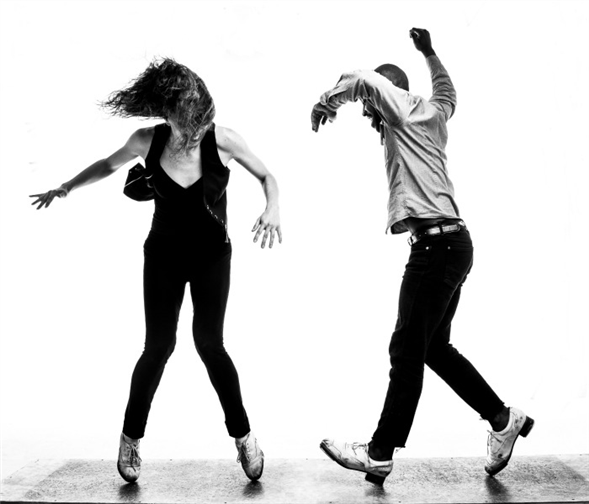Translate Page

The lauded tapper revises Myelination for darker times
---
Science might seem like unusual fodder for a dance-maker, but while reading Daniel Coyle's The Talent Code Michelle Dorrance started musing about myelin, the fatty white substance that surrounds the axon of some nerve cells. "I'm not a neuroscientist, but conceptually I was inspired by that white matter," says Dorrance, a MacArthur-winning tap dancer, choreographer, and director of her own eponymous dance troupe. "Myelin is involved with the building and development of skill. It increases with what's called 'deep practice.' I wanted to explore that idea through dance and music."
Dorrance debuted the short work Myelination in 2015 at New York City Center's Fall for Dance Festival. But for her company's current holiday run at the Joyce Theater, she has completely revamped and expanded the piece, and paired it with the world premiere of Until the Real Thing Comes Along (a letter to ourselves), set to music by jazz legend Fats Waller.
This iteration of Myelination shows off Dorrance's penchant for mixing explosive phrases with highly intricate footwork. It's an approach to dance-making that Dorrance has honed through years of training with the world's top tap stars, including North Carolina Youth Tap Ensemble's Gene Medler and Tony winner Savion Glover. Contributions by her diverse ensemble members -- many of whom are experts in other genres, too, like hip-hop master Ephrat "Bounce" Asherie -- also make their way into her work as she digs into other styles while using tap as her base.
{Image1}
Although Dorrance studied various forms of dance as a child, she was drawn to tap because she loved its musicality. "My mother was a professional ballet dancer, and I grew up at the studio," she says. "But I gravitated toward the musical aspect of tap dance. I've never loved anything more than tap. I'm a musician that uses my feet."
Through Medler, Dorrance met hoofing gurus such as Dianne "Lady Di" Walker and Barbara Duffy, and she attended NYU at a fortuitous time. "Savion was in Bring in 'da Noise, Bring in 'da Funk on Broadway, and people were innovating in tap dance," Dorrance recalls. But college wasn't a good fit for what she wanted to do. "It's nuts how dance departments in general don't respect or support tap," she says. "I think it's a case of institutionalized racism and a lack of understanding of the form."
So she left school to appear in Stomp Off-Broadway. "Creating rhythm and composing music as a tap dancer is so key to me," she says. "That show pushed me to do so with weird items instead of just my body and feet. I loved the challenge and the layered polyrhythms. That still influences me now."
When she broke her foot in 2010, she decided to start Dorrance Dance. "I thought, I'm not getting any younger," she recalls. "My myelin, in its own way, before I even knew about it, had a time limit. And I wanted to create on other human beings that are in my community, have vision, and inspire me."
Over the past seven years, the troupe has earned much acclaim, and Dorrance has finally been able to off-load the administrative duties so she can focus primarily on her work as an artist. That shift shows in this new full-length incarnation of Myelination. "I actually hated the short piece when it premiered," she admits with her usual clear-eyed honesty. "I wanted it to be better. I wanted it to grow, and most of that version was cut." In addition to myelin and the concept of growth, she decided to incorporate character and new vocabulary this time. "It's definitely darker than the original," she says. "It's a reflection of what our culture is going through. There's part of me that's exploring the idea that if you practice negative behavior, you're building myelin just as you do with positive acts. How does that affect us, personally and as a society?"
Myelination 2.0 is performed to live music by Dorrance's brother Donovan Dorrance and Gregory Richardson, with vocalist Aaron Marcellus at the mic, and the choreography was created collectively by the company. "I usually choreograph by myself and bring material to the studio," Dorrance explains. "But in this particular work, I was interested in letting the dancers improv solos and helping them craft the skeletons. I felt this work needed to be personal for each dancer."
Because of that desire, not all of the choreography is set in stone. There's a lot of improvisation, and Dorrance is particularly excited about a group moment when no one knows who's going to do a certain move. "There’s one step we made up that’s quite difficult," she explains. "We can all do it on our right foot, but for some reason, nobody can do it on the left! So on any given night, we decided one person will be tasked with trying to do it on the left." It's rare that a choreographer is willing to put something unmastered into a show, but Dorrance embraces the risk. "That's how we keep growing," she says. "That’s how we keep building myelin."
---
Lauren Kay regularly contributes to TDF Stages..
Top image: Michelle Dorrance and Byron Tittle in Myelination. Photos by Matthew Murphy.
TDF MEMBERS: Go here to browse our latest discounts for dance, theatre, and concerts.